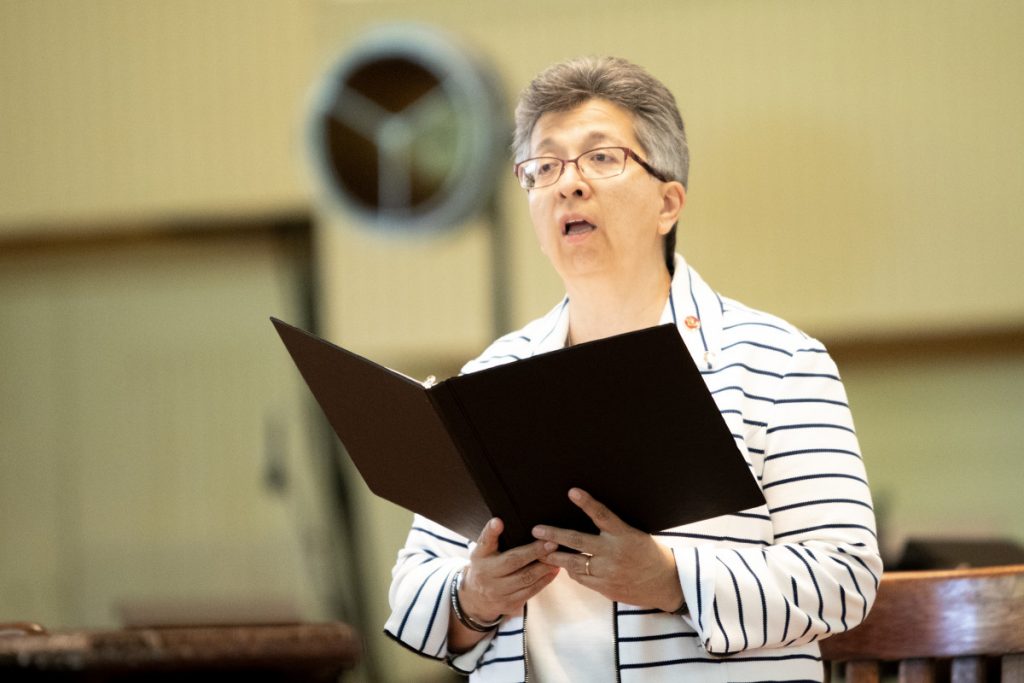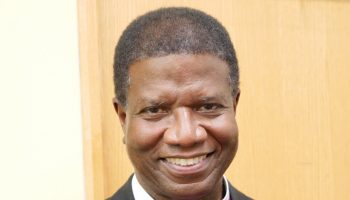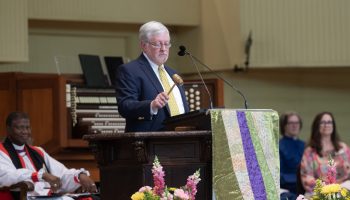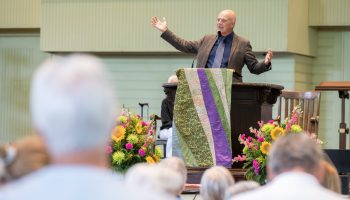
The story of Jesus and the Centurion in Luke’s gospel is one “where the intersection of two cultures and traditions ends in mutual respect and admiration,” said Sister Teresa Maya at the 9:15 a.m. Wednesday morning worship service. Her sermon title was “I Am Not Worthy to Have You Under My Roof,” and the scripture reading was Luke 7:1–10.
The Centurion made Jesus marvel. He said, “I tell you, not even in Israel have I found such faith.” Sister Teresa asked, “How was the Centurion a person of such integrity and character that he was admired for his faith? He was probably not Jewish, yet he helped build the synagogue. Maybe it just needed an expansion.”
She continued, “In the eucharist prayer in the Roman Catholic mass, we pray, ‘Lord, I am not worthy that you should enter under my roof, but only say the word and my soul shall be healed.’ What can we learn from Jesus’ encounters with others? We need to return to the gospels with new questions and new scholars.”
In her “Introduction to the New Testament” class in college, Sister Teresa read In Memory of Her, by Elisabeth Schüssler Fiorenza. “I will always remember how I felt. I was 18, and I did not know there are women in the Bible. I knew the names of the women in the stories, but I never noticed them. I am of the Star Wars generation, and my sister and I fought over who could be Princess Leia or Smurfette in another story line. But Fiorenza taught me to notice my noticing,” she said.
Sister Teresa continued, “I have come to cherish every encounter Jesus had with women. He listened and healed in a culture full of misogyny that has yet to be healed. I also identify with the Centurion, a foreigner and a migrant. What can he teach us about those who are not from here, about how we live with all forms of diversity?”
The encounter of Jesus and the Centurion can teach us how to collaborate to reweave relationships. The first aspect of their encounter was how Jesus noticed others and had conversations with them.
“Do we see the diversity around us?” she asked the congregation. “What do we notice, and what don’t we notice, and how do we notice? Jesus saw the elders coming to him and saw them and welcomed them. I think of the times I failed to notice.”
Sister Teresa was visiting the retirement center of her religious community and a caregiver, Thomasa, stopped her and said, “ ‘You did not see me.’ Why had I not seen her? Was it racism or classism? Why did I see her but fail to ‘see’ her?”
The second action in this encounter is to move. Jesus moved twice — first he entered Capernaum, and then he moved again after speaking with the Jewish elders. Jesus was an itinerant preacher, and it showed up in his teaching and his interactions with people.
“The case for movement is that it gives us a new perspective,” Sister Teresa said. When she was a school principal, one day she stood outside the school at the suggestion of a friend. She continued to stand outside, and one day one of the children asked if Sister Teresa worked for the friend. “That became part of my morning. One of the mothers stopped, and said ‘You are the best principal my child has ever had.’ I reminded her that I was the only principal her child ever had. The mother said, ‘Let me tell you why you are the best — you move among the kids.’ ”
The third action is to listen. Jesus never met the Centurion. When his friends came to Jesus and told him he did not need to go to the house, Jesus listened to the friends. The slave was made well, and Jesus marvelled at the faith of the Centurion and what he had heard.
“How often do we marvel?” Sister Teresa asked. She admitted to being an impatient listener, formulating answers and wishing that people would get to the point, so she can say “Listen to me …”
She continued, “When we truly listen, when we are truly heard, we build bridges that heal and transform.” She cited John Paul Lederach, author of The Moral Imagination: The Art and Soul of Building Peace. He wrote that listening skills were not enough — to truly listen is to “capture the complexity of history in the simplicity of deep listening that offers a haiku back.”
Jesus offered this kind of healing listening, Sister Teresa said. She noted that the most successful reconciliations in the sexual abuse cases of the Roman Catholic Church and other churches were with those who listened to the victims first, with enormous patience, rather than sending in the lawyers.
Jesus listened to the Jewish elders, to the Centurion’s friends, and the slave was healed, and people were transformed. “Jesus was able to listen because he moved and he paid attention,” Sister Teresa said.
Sister Teresa loves the porch culture of Chautauqua. “I love healthy places like parks and sidewalks that are filled with neighbors, so we can listen and notice the diversity. This is how we reweave the fabric of society.”
She continued, “I pray to be like the Centurion: to love the country I live in, to serve my neighbors and look out for those who work for me and to look out for those who are not in these groups. What will you pray to the Centurion for this morning?”
The Rev. Scott Maxwell, a Lutheran pastor, presided. Tom Lengel, co-host at the Hall of Missions, read the scripture. The prelude, “Dolcezza,” by Percy Whitlock, was performed by Owen Reyda, organ scholar, on the Massey Memorial Organ. The anthem was “The Call,” by Ralph Vaughan Williams. Denise Milner Howell, a member of the Motet Choir, was the soloist, and she was accompanied by Laura Smith, organ scholar, on the Massey organ. Smith performed “Scherzo” from Symphony No. 1 by Louis Vierne for the postlude. Support for this week’s chaplaincy and preaching is provided by the Reverend Leonard J. Ebel Chaplaincy. The Motet Choir was at the Hall of Philosophy singing for the graduation of the Chautauqua Literary and Scientific Circle Class of 2025. It was Director of Sacred Music and the Jared Jacobsen Chair for the Organist Joshua Stafford’s birthday.




